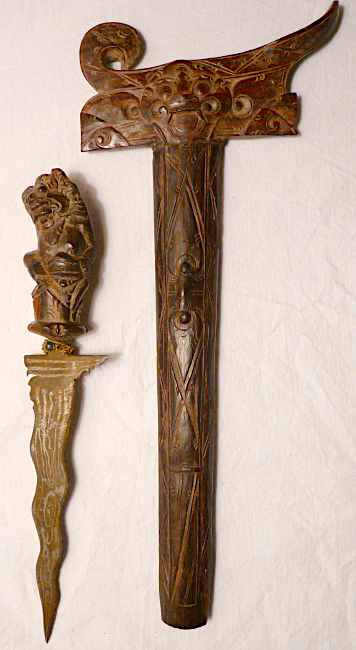Keris
Possibly the single object most strongly associated with the cultures of Indonesia and Malaysia, the keris reached its current form during the Majapahit period in Java, probably during the fourteenth century, though proto examples dating from as early as 300BC have been found elsewhere in Southeast Asia.
A keris can be divided into three parts: bilah (blade), hulu (hilt), and warangka (sheath). All three parts of the keris are objects of art, often carved in meticulous detail and made from various materials: metals, precious or rare types of wood, or ivory. A keris's aesthetic value covers the dhapur (the form and design of the blade, with around 60 variants), the pamor (the pattern of metal alloy decoration on the blade, with around 250 variants), and the tangguh (the age, origin and individual potency of a keris). According to traditional Javanese understandings, keris contain all the intrinsic elements of nature: tirta (water), bayu (wind), agni (fire), bantolo (earth, but also interpreted as metal or wood which both come from the earth), and aku ("I" or "me", meaning that the keris has a spirit or soul). All these elements are present during the forging of keris. Earth is metal forged by fire being blown by pumped wind, and water to cool down the metal. The carved wood of the hulu varies in type by region, with a protective demon such as the one on this example being more common in Bali and Malaysia and a stylized human form (often fetal) being preferred in Java. This keris also features a protective demon carving on the warangka, which is less common
While it is commonly believed that keris were the primary weapons wielded by fighters in the past, they were actually carried by warriors as a secondary armament if they lost their main weapon, which was usually a spear. In Java especially, however, keris were worn on a daily basis, especially when travelling for self-defense. During times of peace, people wore keris as part of ceremonial attire, and it is for ceremonial or formal events that keris are most commonly worn today. Ceremonial keris are often meticulously decorated with intricate carving, and occasionally decorated in gold and precious stones. Heirloom blades are handed down through successive generations and worn during special events such as weddings and other ceremonies.
As both a weapon and an object of great spiritual significance that can choose to bond with or reject a human owner, keris are often considered to have an essence or presence and considered to possess supernatural powers, with some blades possessing good luck and others possessing bad. Keris are used for display, as talismans with magical powers, weapons, a sanctified heirloom (pusaka), auxiliary equipment for court soldiers, an accessory for ceremonial dress, an indicator of social status, a symbol of heroism, etc. Legendary keris believed to possess supernatural power and extraordinary ability were mentioned in traditional folktales, in which they are portrayed as conscious actors with wills of their own.
Wood, iron, metal, glass; 13 x 35.5cm, blade 15.5 cm.
Nelson South East Asia Collection © 2025

